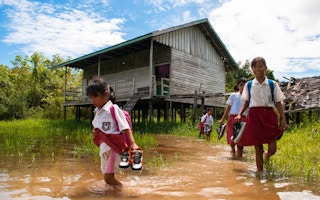Confronting the climate crisis requires a coordinated global response, with funding playing a pivotal role. Within the complex landscape of institutions delivering climate finance, the Green Climate Fund (GCF) is the largest international fund dedicated to tackling climate change.
With US$18.6 billion of capital, it supports developing countries in reducing greenhouse gas emissions and adapting to the increasingly severe impacts of a heating world. This year, 25 countries have pledged a further US$9.3 billion to the Fund’s second replenishment.
Unfortunately, commitments are falling short. This year’s GCF pledges are less than the US$10 billion committed in 2014 and 2019, with fewer countries stepping up. Furthermore, funding is not keeping up with surging inflation. To keep up with rising prices, countries would need to pledge 25 per cent more than they did in 2019.
The GCF represents strong value for money. For every dollar it provides, it raises nearly US$3 from private and public sources. Since 2015, the GCF has financed 228 projects in 129 countries, which are projected to increase the climate resilience of 1 billion people and reduce greenhouse gas emissions by 2.9 billion tonnes—equivalent to the annual emissions of 776 coal power plants.
But its climate benefits extend far beyond these projects. The GCF is key to the Paris Agreement’s grand bargain: that all countries need to do more to address the climate crisis, but the poorest and most vulnerable countries require support from richer countries to do so.
“
Some politicians have claimed that “no government has the money” for climate finance. But governments have proven they can find money when a crisis is urgent enough.
Providing funding through inclusively governed institutions like the GCF encourages developing countries, the source of 63 per cent of annual global emissions, to commit to more ambitious goals. Such indirect effects on emissions may be up to ten times greater than direct emissions reductions from funded projects, according to analysis by the Center for Global Development.
The UN’s stocktake of countries’ climate efforts—which takes place every five years—recently found that the world is not on track to achieve the Paris Agreement’s goals. Yet the costs of inaction far outweigh the costs of action. Now is the time for rich countries to step up with more investment to achieve a safe and prosperous future for all.
Leaders and laggards
Some governments are delivering. Germany is the leading contributor this round with a US$2.2 billion pledge, 33 per cent more than in 2019. Ireland increased its pledge 150 per cent, Denmark doubled, and Canada, South Korea and Spain each increased 50 per cent. Even the UK, which has been rolling back climate efforts in other areas, announced the second largest pledge, US$2 billion.
But other governments, even self-styled climate leaders, are backsliding. Finland has reduced its contribution 40 per cent from 2019. Norway reduced its pledge by 8 per cent, despite making US$174 billion from oil and gas exports last year. In June, President Emmanuel Macron convened a summit on ramping up climate and development finance, yet increased France’s GCF pledge only 4 per cent from 2019 to US$1.7 billion, falling well behind Germany, which it has traditionally matched.
A number of previous contributors missed the October 5 pledging conference, yielding negative headlines. This is not helpful for trust-building with developing countries, already in short supply after developed nations’ repeated failures to meet climate finance goals. Fortunately, governments can still step up since pledges are taken on a rolling basis.
At the pledging conference, the United States, Sweden, Italy, Switzerland, and Australia announced they were working on pledges. They must announce ambitious contributions by the COP28 climate negotiations in December. Strong pledges from the US—originally the Fund’s largest backer—and Australia will be particularly significant after they sat out the 2019 fundraising round.
Eyes will also be on Portugal, one of only two developed countries yet to make a GCF pledge or state its intention to do so. Surprising, since the UN Secretary-General and the Executive Director of the GCF are both Portuguese.
If all developed countries yet to pledge commit at least the same level as their previous contributions, it would bring the replenishment total to US$12.5 billion. This keeps up with inflation. Much more is needed.
Other rich countries like COP28 hosts the United Arab Emirates, whose per capita income and emissions are higher than many developed countries, should step up and pledge to the GCF. They would join ten other emerging economies, including South Korea, Mexico, and Colombia, that have already contributed.
Some politicians have claimed that “no government has the money” for climate finance. But governments have proven they can find money when a crisis is urgent enough.
G20 nations spent US$17 trillion on Covid stimulus packages. The global community has committed US$188 billion in aid to Ukraine since Russia’s invasion. European governments have allocated US$685 billion to help consumers deal with the energy price crisis. Countries have also found money for international funds tackling other global challenges. For instance, the Global Fund to Fight AIDS, Tuberculosis and Malaria raised US$15.7 billion at its replenishment last year.
Governments say climate change is an existential crisis. They need to match their investments with their rhetoric. That starts with ambitious pledges to the GCF.
This story was published with permission from Thomson Reuters Foundation, the charitable arm of Thomson Reuters, that covers humanitarian news, climate change, resilience, women’s rights, trafficking and property rights. Visit https://www.context.news/.











